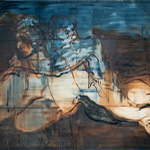The stain…
The silk…
The line…
The stitch…
The scale…
In Garden of Murmurs, Malik Thomas Jalil Kydd’s body of work spanning over the past years offers a reflection into the artist’s introspection of self-identity and personal desires. Often set against the suggestion of vast, rolling landscapes, Kydd’s works are anchored in figuration and grounded in tenderness and the poetics of desire. Bridging painting, drawing and fiber art, he reconciles the tactility of textiles with a sensitive examination of form and an emotive force of line and colour.
These works are about a love broader than just the romantic: the love of the subject by the painter, and the love that pulses quietly through acts of care, memory and preservation. Focusing primarily on the male figure drawn to a scale slightly larger than life-size, what Kydd refers to as an “angel scale”, Kydd has developed a poetic dialogue between material, identity and culture. Painting angels encountered unexpectedly, these figures are approached as a means of adoration and veneration. Amongst abackground of destruction and death, the works evoke a serene world that illuminates from darkness.
Rooted in his engagement with the texture and symbolism of fabric, such as cotton and wool, Kydd’s primary choice of material is raw silk. Sold in a specific measurement of 90 cm width, the artist stitches panels of the material creating an unbounded, limitless surface that echoes the expansive nature of identity: constantly evolving, always stretching beyond the boundaries of form. Serving as a critical element in his process and embedded with vast cultural implications, silk becomes Kydd’s canvas as he constructs his emotional, visceral and conceptual works.
The artist’s use of natural materials adds another dimension to the works. Sage, used for its dyeing properties, becomes not only part of the creative process but a spiritual practice, grounding him in both tradition and personal exploration. Filling the studio with its intense smell, adding an olfactory, multisensorial dimension to his process. This engagement with the sensory experience – sight, touch and smell deepens the works’ emotional resonance, allowing the viewer to experience the work on a visceral level. Kydd’s use of mixed media, such as oil, pastel, charcoal and natural dyes, enhances this interplay.
Specifically, the use of charcoal soaked in linseed oil, which transforms the medium into a pastel-like material, creates rich textures that speak to both the ephemeral and permanent nature of memory and identity. The gestural and linear markings placed by Kydd further contrast the more subdued stains and
drips of the sage absorbed by the silk during the dyeing process. His decision to use these materials connects both to personal narratives and cultural critique, engaging with themes of restriction, transgression and the fluidity of identity.The artist’s use of natural materials adds another dimension to the works. Sage, used for its dyeing properties, becomes not only part of the creative process but a spiritual practice, grounding him in both tradition and personal exploration. Filling the studio with its intense smell, adding an olfactory, multisensorial dimension to his process. This engagement with the sensory experience – sight, touch, and smell deepens the works’ emotional resonance, allowing the viewer to experience the work on a visceral level.
Kydd’s use of mixed media, such as oil, pastel, charcoal and natural dyes, enhances this interplay. Specifically, the use of charcoal soaked in linseed oil, which transforms the medium into a pastel-like material, creates rich textures that speak to both the ephemeral and permanent nature of memory and identity. The gestural and linear markings placed by Kydd further contrast the more subdued stains and drips of the sage absorbed by the silk during the dyeing process. His decision to use these materials connects both to personal narratives and cultural critique, engaging with themes of restriction,
transgression, and the fluidity of identity.
Examining personal desires through symbolic representation, Kydd’s figurative works are not a mere depiction of physicality, nor do they simply embody sensual desire. In contrast to more overtly erotic representations of the male form, Kydd’s works engage with sensuality in a more nuanced way. He delves into the intersections of heritage and the complexities of family relationships as a conduit to his Iraqi roots – these threads are woven subtly, rejecting over-contextualisation of his works. His figures and landscapes instead ask to be felt before they are interpreted.
Such as in his work, They Invaded at Night, Kydd often references sketches of sculptural works from museum visits. Depicting a figure leaning on another, suggesting a relationship between the two, and alluding to the questioning of displacement and the layered terrain of identity, the work examines representations of intimacy. The sense of the relationship expands from a sensual one to an empathetic one, gesturing toward desire as a broader emotional spectrum – a feeling that can be felt towards family, friends and mere strangers who have been put in harm’s way. The work subverts the embrace, and the molded form of the couple becomes something mountain-like, majestic and monumental.
Through his use of natural materials, sacred symbolism, and a quiet reverence for the figure, Kydd invites the viewer to engage with his narratives on a deeply emotional and intellectual level, challenging assumptions and creating space for empathy, understanding, and reflection. His works not only offer an introspective look at his own experiences, they create space for universal connection and develop a poetic exploration of how desire, memory, and identity intertwine.
Text by Judy Karkour
Press release from Carbon 12
Image : Malik Thomas Jalil Kydd. They Invaded at Night. 2025. Oil and charcoal on silk. 220 x 200 cm.
Image courtesy of the Artist and CARBON 12



